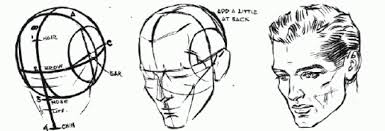Editor’s Note: I posted about my Supplementary series trying to solve the problems and misconceptions of the Loomis method here
Gumroad Product launch: Solving The Problems Of the Loomis Method
Check It Out Here!
I also have a YouTube video about it here:
Introduction
There has been an issue I had with the Loomis method of drawing heads when I first started practicing it years ago and how it is presented and admittedly it can be solved with proper practice of ellipses and perspective of the circle, enough guesswork to suit your own needs and reference to real life proportions. However, I still feel the need to address it. Starting out with the book’s method without properly learning perspective of the sphere at first can be detrimental to your efforts.

The Loomis method is based on a average/ideal proportion system, the hair line to the brow line is the same as the brow line to the nose line and also the same as the nose line to the chin line. It starts out with the circle/sphere, brow line and center line, but without a proper knowledge of the sphere in perspective and how the cross counter lines work on a sphere it can be detrimental to just keep copying what the book shows/solely rely on the book.
But that’s not the only problem, another one is the Loomis method going, now cut a little bit from the sides, now this needs guesswork cause how much is actually a little bit, how much is too much, the method starts with very proper even mathematical proportions that is followed by a rough method of “just cut a little bit off the sides” This side plane represents the side of the head, which are flat and also turns accordingly to perspective which is where ellipses come into play. Just copying the planes in the book is not enough. You have to know and understand ellipses to some extent and also from real reference experience know how much to remove. Remove too little and have you a huge misshapen head, remove too much and you get a impossibly narrow for realism standards one.
Why bring this up? It is vital and bears reminding that just throwing the Loomis method or any other step-by-step method to drawing anything at beginners has a detriment of them sticking to it as the only way to draw something, not focusing on real core fundamental skills like perspective and proportions. They will copy the planes faithfully but cannot replicate it properly by themselves, there’s no active reflective practice with reference to real life.
Every construction method should be a crutch to be semi-discarded upon internalizing it with enough drawing and practice to apply to your own purpose in drawing regardless.
Do you have any problems with conventional drawing practice methods regularly suggested by drawing instructors/the internet? What information do you find is lacking from a lot of tutorials?
If you liked what you read, please consider supporting me on Patreon (monthly) or ko-fi (one time donations).
Stay safe~!
JR

Leave a reply to starkickfall Cancel reply